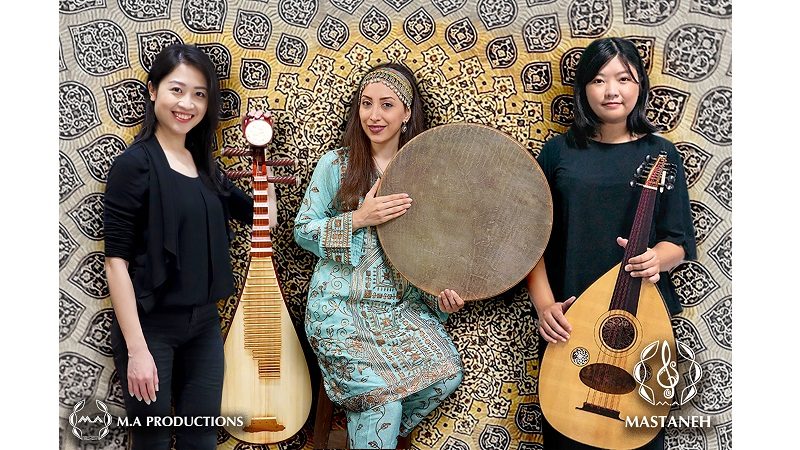A Performance Merging Two Civilizations
Mona Kaveh Ahangari and Ali Montazami speak with Music Press Asia’s editor-in-chief Monica Tong to uncover the cultural influences of these traditional instruments and why it is important to keep them alive.
Mona Kaveh Ahangari and Ali Montazami speak with Music Press Asia’s editor-in-chief Monica Tong to uncover the cultural influences of these traditional instruments and why it is important to keep them alive.

In the hope to grasp how traditional musical instruments of Central and Eastern Asia are being expressed today, Music Press Asia speaks to the co-founders of MASTANEH, a music group formed using traditional Iranian and Chinese musical instruments.
Ali Montazami and Mona Kaveh Ahangari are husband and wife from Iran. In 2017, they founded M.A PRODUCTIONS, an art, science, and cultural group based in Taiwan. Ali is a Professional Futurist, Film Director, Mechanical Engineer, Industrial Designer, and multi-skill Artist with more than 25 years of multidisciplinary experience. He is the director of M.A PRODUCTIONS. Prior to Taiwan, Ali was General Manager at Renault-Nissan-Mitsubishi Car Manufacturer Alliance in Iran.
Mona is the first and only Professional Daf Musician and Teacher in Taiwan. Today, she leads MASTANEH and DAFSUN, the two music bands that are subdivisions of M.A PRODUCTIONS and are the only bands in Taiwan that perform Iranian music. Prior to arriving in Taiwan in 2018, Mona taught and performed Daf domestically and internationally as a fixed member of several well-known music Ensembles and Orchestras for 13 years and also a certified professional Daf player and member of “Iran House of Music”.
1. How would you describe the sound of MASTANEH to us?
Ali Montazami: MASTANEH is the first and only Iranian music band in Taiwan. This is a band from M.A PRODUCTIONS Group and provides the unique and less experienced sense of Iranian music in Taiwan. Mona Kaveh, my wife, is the leader of the band who also plays Daf which is a unique and special frame drum from Iran. Ting-Yu Liu is our Pipa player and Pang-Yi Lee is our Barbat (Oud) player.
The word MASTANEH is a Persian word that means the feeling of freedom and joy like a drunk person, but not through drinking alcohol. We experience a similar feeling when doing meditation, or listening to the music that we love, or praying, and or feeling a kind of connection to the source of being. Let’s say MASTANEH is a “drunk soul” like feeling.
Mona Kaveh Ahangari: Bringing the feeling of MASTANEH to our audiences is an objective to us when we perform. Obviously, at the first level, the band members need to feel joy by each song, then we can expect that this joyful feeling may transmit to the audience as well. We highly benefit from the specialty and strong personality of our musical instruments in achieving our objective.
Daf is 1700 years old frame drum that originated in the Kurdish part of Iran. A specific uniqueness of Daf compare to other frame drums like Tar, Riq, Bendir, etc. is the 200 metal rings behind it which generate special sound for Daf. Knowing that Daf is being used for many years as a spiritual music instrument may let you imagine the feeling of listening to this instrument. Nowadays, Daf is used to perform different musical styles and not only spiritual music. Ting-Yu, our Pipa player, compares the sound of Daf to horses galloping on the grassland.
Barbat, also known as Oud or Lut, is a 1400 years old musical instrument invented by Persian musician Barbad. This instrument is being vastly used in the Middle East, Central Asia, and North Africa. To me, Barbat sounds like the wind in a desert, full of dreams and mystery. Pipa, another instrument of MASTANEH, is one of the most popular Chinese instruments which also has family roots with Barbat. Surprisingly, Pipa has a broad sound range that lets us use it in place of some Persian music instruments in our band. Ting-Yu compares her Pipa to water which has multiple appearances. To me, the sound of Pipa is like telling stories from deep far history.
After all, dancing these three instruments together creates the music which contains both historical and modern elements along with each other with the potential of generating a broad range of emotions for the players and also its audiences.
Click here to read page (2).




